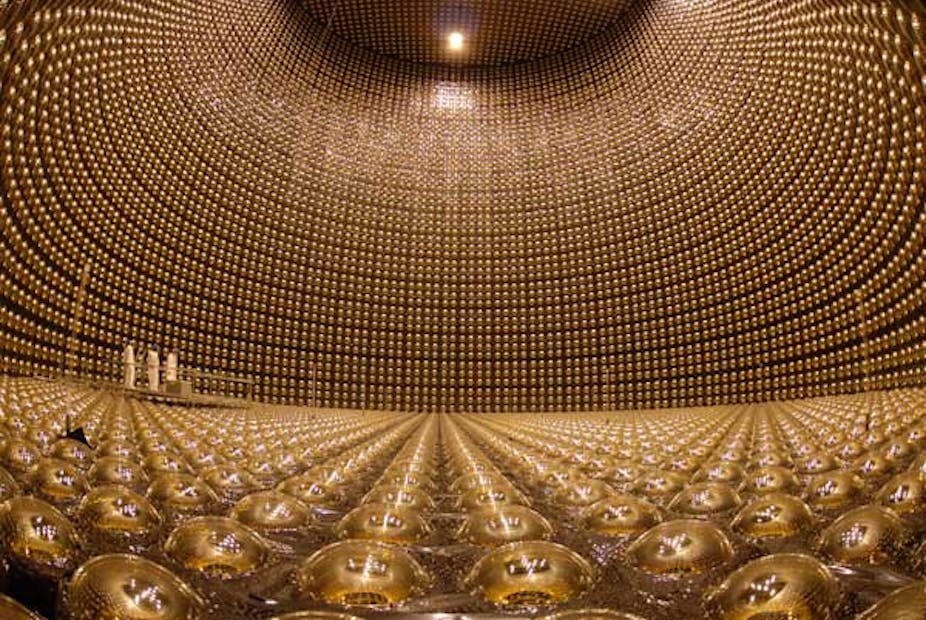Of all the known particles in our universe, neutrinos are perhaps the most elusive; their origins are mysterious, their purpose unknown and they are notoriously difficult to detect.
You’ll already know that ordinary, everyday matter is made up of combinations of “elementary” particles called protons, neutrons and electrons. Put these together in different arrangements and you can make any of the substances we see around us, from air to plastics to steel.
But there are many other weird and wonderful particles we don’t encounter in everyday life. Some of these are unstable and exist only briefly before disappearing in a flash of energy. Others pass, ghostlike and unseen, through the everyday world.
The first hint that neutrinos – perhaps the most ghostly of these – existed came in 1930 when a physicist, Wolfgang Pauli, noticed that in certain nuclear processes, particles would jump off in random directions as if they’d been pushed.
He guessed that this was because there was another unseen particle involved (the neutrino) that was giving them a kick in the opposite direction.
The problem? While the particle he proposed turned out to be very convenient for his theory, it also turned out to be very hard to detect.
As physicists, we normally see things by measuring reflected particles of light known as photons. Unfortunately, neutrinos don’t reflect photons and, even if they did, move too quickly to be spotted in this manner.
Another way physicists detect particles is by placing something solid, such as a brick, in their path, then looking for the resulting flash of energy when the particle hits it.
But this too presents issues: as a technique, it’s a bit like trying to figure out what a tennis ball is, without ever having seen one, by listening to a Wimbledon match: it’s possible, but not particularly easy.
The problem is that neutrinos pass through familiar forms of matter almost as if it wasn’t there.
Our sun emits vast numbers of neutrinos, and billions pass through you every second, but only one in a trillion stops or slows down as it passes through your body.
In the 1950s, Fred Reines and Clyde Cowan built detectors out of tanks of water and surrounded them with very sensitive cameras so that when that one-in-a-trillion neutrino happened to interact with the water, they could catch the tiny flash of light it produced.
Eventually they had success. In 1956, the Cowan-Reines experiment detected several neutrinos, confirming Pauli’s speculation from more than two decades earlier.
But the fact neutrinos are so elusive also has some advantages.
Astronomers normally use telescopes to look at light, but this light can be blocked by dust clouds or dense radiation fields in the space between stars.
Neutrinos pass straight through all of this cosmic interference, giving us valuable information about what might be happening on the other side.
Suppose the nuclear furnace at the centre of the sun went out: it would be tens of thousands of years before the outside of the sun cooled down; and, because of interference, we wouldn’t notice it getting dimmer.
But the neutrinos coming from the centre of the sun would stop immediately, and we’d notice this within minutes.
Thankfully, we don’t seriously expect the sun to go out any time soon, but some other stars (not like our sun) do turn themselves off in massive explosions called supernovae. Looking at the neutrinos from inside those explosions can tell us much about what is really going on.
Stars are not the only astronomical objects to produce neutrinos. There are massive black holes at the cores of distant galaxies.
Neutrinos from those galaxies (if we’ve got the theory right) should be travelling very close to the speed of light, much faster than those from the sun or supernovae.
We expect them to be very rare, so we either need to wait a lot longer before we see one, or to build huge detectors to catch more of them. Fortunately, we can cheat a bit.
Since these neutrinos are travelling at an incredible speed, they make powerful flashes when they hit something. So, rather than building our own detector, we just watch something big (such as Antarctica, or the moon) for a little burst of light.
Also, there’s a chance neutrinos are responsible for the shape of the universe. When we look at other galaxies, we can see they have been pulled around by the gravity of some invisible clumps in space, which we call dark matter. Could these be clumps of neutrinos?
We don’t know yet, but we’ll do our best to find out.

